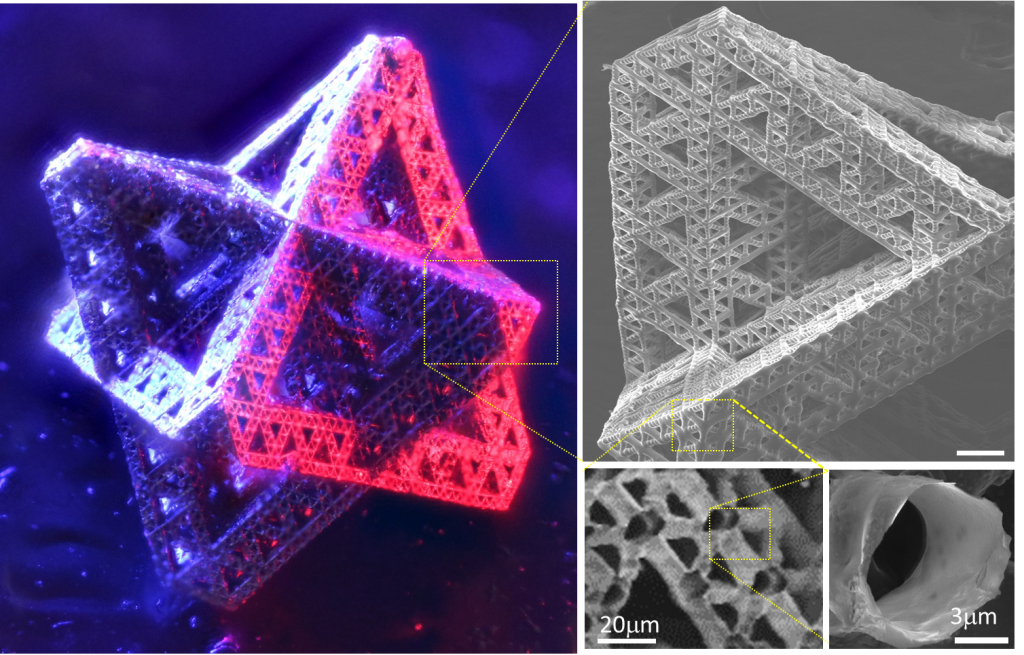Xiaoyu Zheng (15-LW-083)
Abstract
There has been a lengthy research and engineering pursuit to create lightweight and mechanically robust and efficient materials with interconnected porosity. These porous materials are desirable for a wide range of applications including thermal insulation, active cooling, catalyst supports, energy storage, infiltration, and biomaterials. However, these required outstanding properties have remained elusive on the bulk scale, constrained by the inherent coupling of material properties and the lack of suitable processes to generate the artificial materials. The critical challenge is the significant degradation of material property as the relative density is reduced. We plan to develop a new class of novel materials based on multiple hierarchies and unusual nanometer-scale size effects, which will lead to a new class of engineering materials with vastly superior properties that is largely unclaimed at ultralow relative density. We will develop a new class of metamaterials with ordered hierarchies that offer extremely low mass densities (lighter than aerogels) with unprecedented properties (metamaterials are materials engineered to have properties that are not found in nature). We will investigate how fractal hierarchical orders and nanoscale size serve to change the scaling of material properties against density.
We expect to develop a method of constructing a digitally designed metamaterial with extremely low mass densities. Lightweight, porous, and strong materials found in nature such as bone or wood are composed of hierarchical cellular materials—that is, a cellular architecture that is made of finer cells in successive smaller scales. Nesting multiple hierarchical levels offer significant benefits to the mechanical properties of these materials. In addition, materials become insensitive to flaws at nanoscale. Namely, the nanometer-scale size effect at the lowest hierarchical level plays a key role in the enhancement of overall strength, stiffness, and fracture resistance of a material. We anticipate this new class of man-made material, arising from nanoscale size effects within high order of hierarchical material, will allow new material designs with vastly superior properties. Based on fractal design methodologies developed in this work, we will be able to design hierarchical materials that are extremely mechanically efficient in sizes ranging from nanometers to micrometers. A range of constituent materials such as polymers, metals, and ceramics will be used as the base material for the microscale unit cells, which will constitute the building blocks of these lattice architectures.
Mission Relevance
Our planned ultralight, high-surface-area materials have application in several Laboratory mission areas including energy security, bioscience and bioengineering, and high-energy-density science. These materials can be used for, among other applications, thermal insulation for increased energy efficiency, energy storage in solar cells, biomedical implants, and targets for Inertial Confinement Fusion experiments. The research, therefore, supports a variety of LLNL strategic focus areas including inertial fusion science and technology and energy and climate security, as well as the advanced materials and manufacturing core competency.
FY15 Accomplishments and Results
In FY15 we (1) successfully designed, fabricated, and demonstrated fractal octet lattices up to the third order using polymer and metal, with relative densities as low as 0.08% of the bulk materials; (2) designed and manufactured hierarchical lattices with a combination of deformation mechanisms using a designed lattice library, which offer unprecedented specific strength and energy-absorbing capability; and (3) developed a customized code for generating fractal lattices within minutes, which is a significant time savings when compared to commercially available software.
Publications and Presentations
- Zheng, X., et al., Multi-scale metallic metamaterials. (2015). LLNL-JRNL-677190.






